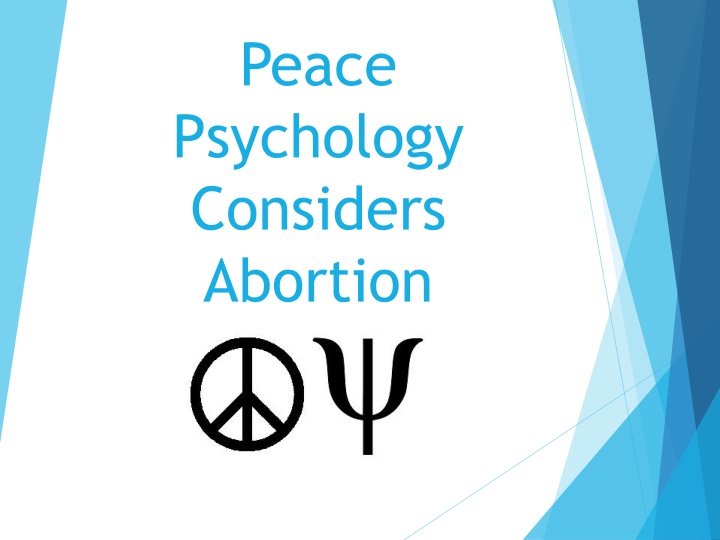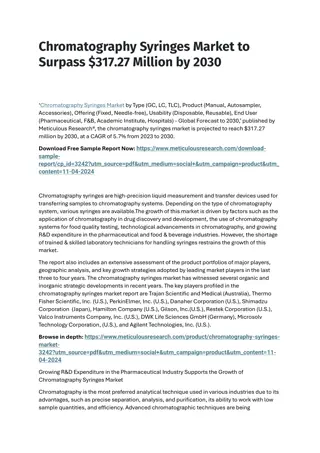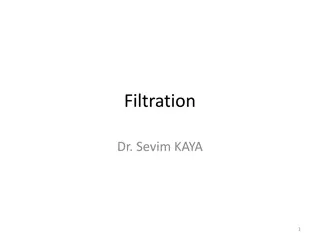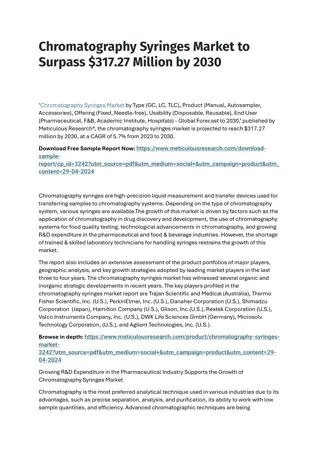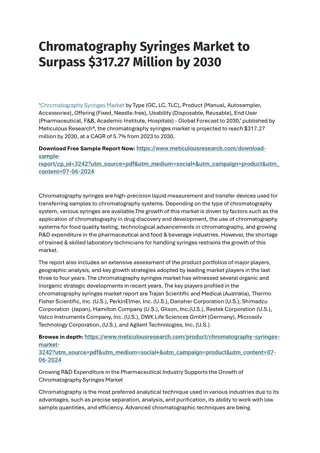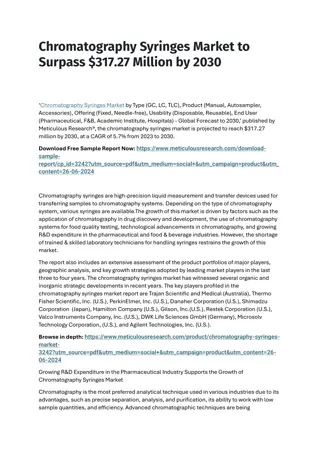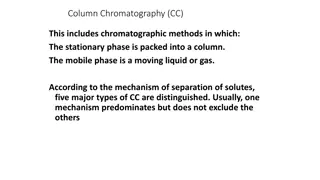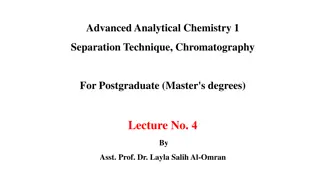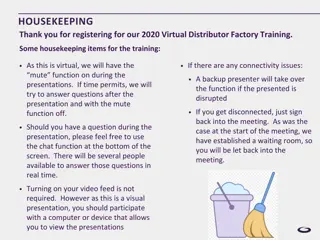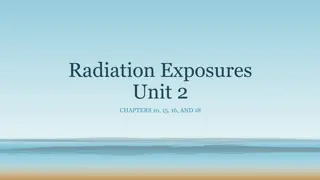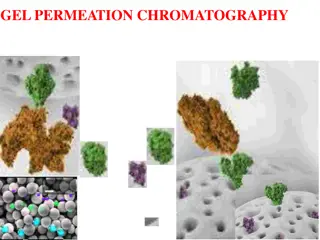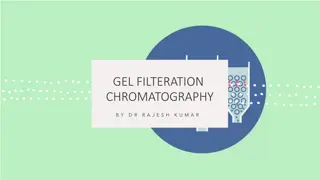Introduction to Gel Filtration Chromatography
Gel Filtration Chromatography (GFC) is a technique used to separate molecules based on size differences as they pass through a medium in a column. This method does not bind molecules to the medium and is commonly employed for separating biological molecules and determining molecular weights. The process can be utilized for group separations and high-resolution fractionation. Additionally, the partition coefficient plays a crucial role in GFC by helping in the elution of molecules based on their size. Understanding the void volume is also essential in GFC for effective separation. Learn more about the applications and principles of Gel Filtration Chromatography in this informative guide.
Download Presentation

Please find below an Image/Link to download the presentation.
The content on the website is provided AS IS for your information and personal use only. It may not be sold, licensed, or shared on other websites without obtaining consent from the author.If you encounter any issues during the download, it is possible that the publisher has removed the file from their server.
You are allowed to download the files provided on this website for personal or commercial use, subject to the condition that they are used lawfully. All files are the property of their respective owners.
The content on the website is provided AS IS for your information and personal use only. It may not be sold, licensed, or shared on other websites without obtaining consent from the author.
E N D
Presentation Transcript
Peace Psychology Considers Abortion
Continuum of Positions Option Violence Tragic Necessity
Status of Fetus OPTION: Non-person / Tissue VIOLENCE: Human Being / Baby TRAGIC NECESSITY: Like Animal
Hypotheses: Child Abuse Option: Because unwanted children are for the most part not born, child abuse and neglect (excluding sexual abuse) will be lower in those places and times in which abortion is legal or otherwise readily available. Violence: Because abortion models violence as a way of solving problems, and diminishes the taboo against hurting children, child abuse will be higher in those places and times in which abortion is legal or otherwise readily available.
Child abuse rate per 1,000: 1973 2.16 1990 11.59 (Bureau of Census) The child abuse rate and the abortion rate both fell steadily after this.
Coleman et al. (2005) 518 women identified by Baltimore Child Protective Services as having abused their children. at least one induced abortion: 114% more likely to be identified as having abused their children, compared to women with no loss. Involuntary loss (miscarriages) were no more likely to be identified as abusive than women with no pregnancy loss.
Problem of the Super-Wanted Lenoski (1980), 674 emergency room visits due to abuse compared with 500 controls from the same emergency room 91% of the parents of abused children said they had wanted the pregnancy; 63% of the non-abused said so; 93% of the parents were married at the time of the birth of the abused child; 60% of the non-abused were; the mother of the abused children began wearing maternity clothes at an average of 114 days into the pregnancy, as compared to an average of 171 days for the mothers of the non- abused children; The child was named after a parent (usually, father s name with Jr. ) in 24% of the abused cases, but only 4% of the non- abused cases.
Intimate Partner Violence
Many, many studies IPV is more likely to lead to a pregnancy occurring that wasn t wished for. IPV is more likely to lead to coerced abortions, as coercion is already inherent in the relationship. The prevalence of IPV is about three times greater in those seeking abortion than in those continuing their pregnancies. These points aren t controversial, but as for conclusions: Any program preventing IPV also prevents abortion and Screening for IPV at abortion facilities can help find where interventions might help.
From the Washington Post [A] 33-year-old woman . . . said she struggled for weeks, trying to decide between her religion and her love for children on the one hand and her inability to support a newborn baby on the other. Finally she went ahead with the abortion. The Catholic mother of two said she spent the night crying and praying . . . I would never do this in peacetime and God knows I wanted that child, but there is no food for him in my house, she said. There is nothing. What could I do? Such stories are common and the dynamic is obvious add this to the long list of reasons that war is intolerable.
If someone is being trafficked which is to say, under the domination of a pimp/trafficker she is by definition unable to provide informed consent to an abortion . . . The victim has no voice in this decision. Indeed, providing such services to a victim of sexual trafficking benefits only the trafficker by getting the victim back out on the street and making money sooner. The average age of entry into commercial sex exploitation is about 14. The average life expectancy of someone in commercial sexual exploitation is seven years. Start at 14, dead by 21. The mortality rate for someone in commercial sexual exploitation is 40 times higher than for a non- exploited person of the same age. Helping a victim return to exploitation more quickly by terminating a pregnancy increases the odds of death. -- Stephen Wagner, National Catholic Reporter, 11/29/2011
Impact of Abortion Availability on Sexual Abuse We know of many cases where sexual abuse of minors continued because the perpetrator covered up the crime by taking her to an abortion clinic. Since efforts to conceal are mainly successful, there are undoubtedly many more. Whenever abortion clinics don t turn in the perpetrator, they facilitate him and therefore may sexual abuse more likely.
Impact on Women as Whole
Question: Equality Option: Control of reproductive lives is necessary for women s equality. Violence: Telling women they must have surgery order to be treated equally is disparaging female biology and therefore a form of privileging male characteristics.
Question: Discrimination Option: Forcing women to continue pregnancies is itself a form of gender discrimination. Violence: When pregnancies are regarded as optional rather than a condition to be accommodated, then those employers and schools who understand themselves to be inconvenienced are more likely to discriminate against pregnant women.
Question: Pressure for Sex Option: Women having control over their own bodies is all of a piece, including both sex and pregnancy. They are freer to have the sex they wish with abortion as an option. Violence: We still live in a patriarchal culture in which men feel entitled to sex. The surgery of abortion is one that women undergo, but the man does not, so he s not the one that takes the consequences.
Question: Pressure to Abort Option: The option is for women; they make the decision. Violence: Employers, men who want to avoid child support payments, parents who don t want their teenager to embarrass them the rhetoric of choice can mask the fact that it s their choice, not hers.
Question: Feminization of Poverty Option: Female poverty would go down as women aren t straddled with children they can t afford. Violence: Female poverty would go up because men will feel justified in avoiding all paternal responsibility, including child support. The birth happened due to her choice, not his. Epidemiological Result: After 1973, out-of-wedlock births and female poverty shot up.
